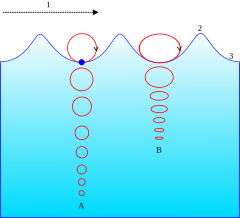Physical concepts
Waves are generated by wind passing over the sea: as long as the waves propagate slower than the wind speed just above the waves, there is an energy transfer from the wind to the most energetic waves. Both air pressure differences between the upwind and the lee side of a wave crest, as well as friction on the water surface by the wind shear stress cause the growth of the waves.[3] The wave height increases with increasing wind speed, duration since the wind started to blow, and of the fetch (the distance of open water that the wind has blown over), see Ocean surface wave.
In general, large waves are more powerful. Specifically, wave power is determined by wave height, wave speed, wavelength, and water density.
Wave size is determined by wind speed and fetch (the distance over which the wind excites the waves) and by the depth and topography of the seafloor (which can focus or disperse the energy of the waves). A given wind speed has a matching practical limit over which time or distance will not produce larger waves. This limit is called a "fully developed sea."
Oscillatory motion is highest at the surface and diminishes exponentially with depth. However, for standing waves (clapotis) near a reflecting coast, wave energy is also present as pressure oscillations at great depth, producing microseisms.[3] These pressure fluctuations at greater depth are too small to be interesting from the point of view of wave power.
The waves propagate on the ocean surface, and the wave energy is also transported horizontally with the group velocity. The mean transport rate of the wave energy through a vertical plane of unit width, parallel to a wave crest, is called the wave energy flux (or wave power, which must not be confused with the actual power generated by a wave power device).





No comments:
Post a Comment